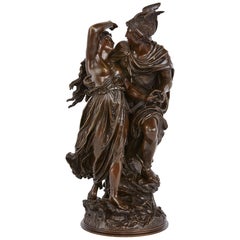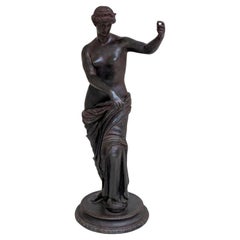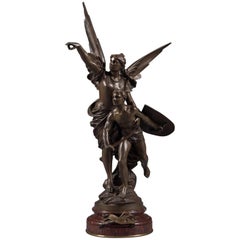L. Gregoire Furniture
to
1
2
2
2
2
2
2
2
2
2
2
1
12,317
3,886
2,479
2,226
Creator: L. Gregoire
Patinated Bronze Antique Sculptural Group of Andromeda and Perseus by Grégoire
By L. Gregoire 1
Located in London, GB
This fine antique French sculpture depicts a moment from one of the most famous tales from Classical mythology, that of Perseus and Andromeda....
Category
19th Century French Classical Greek Antique L. Gregoire Furniture
Materials
Bronze
$8,964 Sale Price
30% Off
19th Century Clock Garniture by L. Gregoire
By L. Gregoire 1
Located in Brighton, Sussex
A very impressive and striking French 19th century bronze clock garniture by L. Gregoire. Having classical silvered figures above the clock ...
Category
1860s French Antique L. Gregoire Furniture
Materials
Bronze
$37,745 / set
Related Items
Italian Minerva Patinated Bronze Sculpture
Located in Astoria, NY
After the Antique Venus of Capua Patinated Bronze Sculpture, 20th century, possibly cast by Chiurazzi, the standing draped figure with outstretched arm, with a foot resting on a helm...
Category
20th Century Italian Classical Greek L. Gregoire Furniture
Materials
Bronze
Fine French Patinated Bronze Figural Group Titled Pro Patria by Edouard Drouot
By Edouard Drouot
Located in Tarzana, CA
A very fine French antique patinated bronze figural group titled Pro Patria by Edouard Drouot
(French, 1859-1945) late 19th century.
Depicting a figure of winged Victory with a ...
Category
Late 19th Century French Late Victorian Antique L. Gregoire Furniture
Materials
Bronze
$16,250
H 30 in W 18 in D 9 in
19th Century French Louis XVI Style Mantle Clock Garniture Set
By Samuel Marti, Raingo Frères
Located in Forney, TX
A luxurious French Louis XVI style gilt bronze ormolu and alabaster (onyx-marble) three piece mantle clock and garniture set, possibly attributed to Raingo Freres.
The fine quality antique originating in France in the late 19th century, exquisite Parisian work, exceptionally executed in opulent, elegant, and sophisticated King Louis XVI style, timeless neoclassical taste, comprising: classical architectural case mantel clock, having pointed bronze doré finial, flanked by scrolled foliates and lyre motifs, fancy enamel dial with Arabic numerals, inscribed F. Lapointe, Paris, eight-day time-and-strike movement signed Samuel Marti 1900 (Paris, 1870-1890), original Apollo mask sun-burst pendulum hanging below clock drum, flanked by matched pair of two arm candlestick garnitures, each with matching scrolled foliates and lyre finial, tapering column support with two candle nozzles, rising on stepped molded base, terminating in patinated brass disc feet.
Markings:
Pendulum stamped "R" "1721" ormolu on clock & garnitures stamped "1321"; possibly attributed to R. Freres / Raingo Freres.
Dial signed by French enameller "F. Lapointe, Paris"
Movement stamped by the firm of well-known French clockmaker Samuel Marti et Cie, Paris, second half of 19th century.
Dimensions: (approx)
As pictured:
18.5" High, 36" Wide, 5.5" Deep; 27.5 lbs total.
Clock:
18.5" High, 13" Wide, 5.5" Deep;
Candelabra garnitures: (each)
12" High, 8" Wide, 4.25" Deep;
Condition:
Presents splendidly. Great original unrestored antique condition. Currently not operating as it's lacking a suspension spring. Retaining bell, pendulum, and key. Losses to decorative elements. Wear consistent with age and use.
To ensure the clock arrives as beautiful as it leaves here, and due to the rather delicate nature of antique clocks...
Category
19th Century French Louis XVI Antique L. Gregoire Furniture
Materials
Alabaster, Bronze, Enamel, Ormolu
$3,500 / set
H 18.5 in W 36 in D 5.5 in
Large French 19th Century Black and Green Marble Clock Garniture
Located in LA CIOTAT, FR
This exceptional Napoleon III period mantel clock set, dating to the late 19th century, exudes elegance and sophistication. The set includes a pendulum clock and two matching cassole...
Category
19th Century French Napoleon III Antique L. Gregoire Furniture
Materials
Marble, Bronze
$2,780 / set
H 18.71 in W 14.97 in D 5.91 in
19th Century Louis XVI Style Bronze Ormolu Mantel Clock Garniture
Located in Casteren, Noord-Brabant
A very fine Louis XVI style figural mantel clock with matching flanking candelabra. The clock is bronze casted and has an ormolu f...
Category
1880s French Louis XVI Antique L. Gregoire Furniture
Materials
Carrara Marble, Bronze, Ormolu
$3,907
H 12.21 in W 9.45 in D 3.94 in
French 19th C Gilt and Patinated Bronze Group of Gloria Victis, by A. Mercie
By F. Barbedienne Foundry, Antonin Mercie
Located in New York, NY
An Incredible and Large Gilt and Patinated Bronze Group of Gloria Victis, a Winged Figure of Victory with a Fallen Warrior. This incredible bronze piece was cast after a model by Maarius-Jean-Antonin Mercié, This model is signed 'F. BARBEDIENNE FONDEUR PARIS' demonstrating that it was cast by Ferdinand Barbedienne's foundry, the best bronzier of the 19th century. The base is further signed 'A. Mercie' and stamped 'Réduction Mécanique' with an inscription of '659'. The figure is mounted on a Belgian noir marble base with various stepped edges. Gloria Victis is one the most well-known and important bronze casts of the 19th Century. The quality of this particular model is absolutely incredible and all the marking indicate that this particular piece is one of the finest produced by the Foundry.
A student of Jouffroy and de Falguière at the Ecole des Beaux-Arts, Marius-Jean-Antonin Mercié (1845-1916) won the Grand Prix de Rome at 23 years old with his work Thésée vainqueur du Minotaure. In 1872, he sent the plaster model of his work David vainqueur to the Salon, for which he won the first class medal. At the same time, he received La croix de la Légion d'honneur at the Villa Medici. His return to Paris, in 1874, issued in a long and brilliant career with numerous commissions, notably the monuments for Louis-Philippe and Queen Marie-Amélie for the Royal Chapel at Dreux (1886).
By the age of 30 Mercié was already very well-known and his Gloria Victis received resounding success when it was exhibited at the Salon, in 1874 (in plaster) and in 1875 (in bronze). This work exalted the heroism and the patriotic sentiments aroused by the disasters of 1870. His predilection for patriotic subjects is shown in many of his works such as Quand même...
Category
19th Century French Louis XVI Antique L. Gregoire Furniture
Materials
Belgian Black Marble, Bronze
$23,780 Sale Price
20% Off
H 31.5 in W 9.5 in D 8 in
Bronze Group "Perseus And Andromeda" By Jean-Louis Gregoire
By Jean Louis Grégoire
Located in Norwood, NJ
19th century French bronze sculpture "Perseus Freeing Andromeda" by Jean-Louis Grégoire (French, 1840-1890). Signed on base L Grgoire.
Subject matter is "Perseus and Andromeda...
Category
Late 19th Century French Antique L. Gregoire Furniture
Materials
Bronze
19th Century French Bronze Group of Nessus Abducting Deianira
By Giambologna
Located in Dublin, IE
French Grand Tour bronze group of Nessus abducting Deianira after Giambologna on marble base.
After the model by Giambologna
Circa 1880
French
Footnote:
The first documented example of this famous bronze group was made by Giovanni Bologna...
Category
19th Century French Classical Greek Antique L. Gregoire Furniture
Materials
Marble, Bronze
$13,321
H 25.99 in W 18.12 in D 13.19 in
19th Century Antique French Neoclassical Style Gilt Bronze Clock Garniture
Located in Dublin, IE
An exceptional quality three-piece clock set designed in a grand neoclassical style by 'Domange Rollin Rue de Bretagne Paris'. France.
The set is comprised of a central clock and tw...
Category
19th Century French Louis XVI Antique L. Gregoire Furniture
Materials
Enamel, Ormolu
$20,426 / set
H 20.08 in W 14.18 in D 5.91 in
19th Century Gilded Bronze Sculptural Group
Located in Madrid, ES
This elegant 19th-century gilded bronze sculptural group is a stunning piece of art. It is mounted on white Carrara marble, which enhances its overall beauty and grandeur. The sculpt...
Category
Early 1900s Antique L. Gregoire Furniture
Materials
Bronze
A Continental 19th century Bronze and Marble statue of Perseus and Medusa
Located in West Palm Beach, FL
An exceptional Continental 19th century Grand Tour Period patinated Bronze, Black Belgian, and Rosso Alicante marble statue of Perseus and Medusa. This handsome statue of Perseus hav...
Category
19th Century Unknown Grand Tour Antique L. Gregoire Furniture
Materials
Marble, Bronze
$10,780
H 20.5 in W 6.5 in D 4.75 in
Patinated Bronze Sculpture of a Deer by Hagenauer
By Karl Hagenauer
Located in Pittsburgh, PA
This whimsical sculpture of a stag is from the famed Werkstatte Hagenauer Wien.
Category
Mid-20th Century Austrian Mid-Century Modern L. Gregoire Furniture
Materials
Bronze
L. Gregoire furniture for sale on 1stDibs.
L. Gregoire furniture are available for sale on 1stDibs. These distinctive items are frequently made of metal and are designed with extraordinary care. There are many options to choose from in our collection of L. Gregoire furniture, although gold editions of this piece are particularly popular. If you’re looking for additional options, many customers also consider furniture by and August Moreau. Prices for L. Gregoire furniture can differ depending upon size, time period and other attributes — on 1stDibs, these items begin at $2,495 and can go as high as $34,685, while a piece like these, on average, fetch $11,991.



